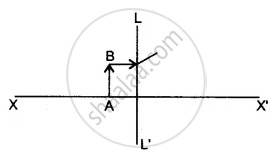Advertisements
Advertisements
प्रश्न
A diverging lens has a focal length of 0.10 m. The power of this lens will be:
विकल्प
+10.0D
+1.0D
−1.0D
−10.0D
उत्तर
10.0D,
since power of lens=`1/"focal length"=1/-0.10=-10.0D`
APPEARS IN
संबंधित प्रश्न
What is the focal length of a convex lens of focal length 30 cm in contact with a concave lens of focal length 20 cm? Is the system a converging or a diverging lens? Ignore thickness of the lenses.
Consider two statements A and B given below:
A: real image is always inverted
B: virtual image is always erect
Out of these two statements:
The optician's prescription for a spectacle lens is marked +0.5 D. What is the:
(a) nature of spectacle lens?
(b) focal length of spectacle lens?
Two lenses A and B have focal lengths of +20 cm and, −10 cm, respectively.
(a) What is the nature of lens A and lens B?
(b) What is the power of lens A and lens B?
(c) What is the power of combination if lenses A and B are held close together?
A normal eye is not able to see objects closer than 25 cm because
The power of a lens is +2.0 D. Find its focal length and state the kind of lens.
Complete the diagram to show the formation of the image of the object AB.

(i) Name the Lens LL’.
(ii) Where is the image of the object AB formed?
(iii) State three characteristics of the image.
If there is a convex lens of focal length 75 cm and a concave lens of focal length 40 cm, then calculate their combined power and combined focal length.
The power of the magnifying glass depends on the distance of the magnifying glass from object.
An object is kept at a distance of 1m from a lens of power +2D:
- Identify the type of lens.
- Calculate its focal length and distance of the image formed.
